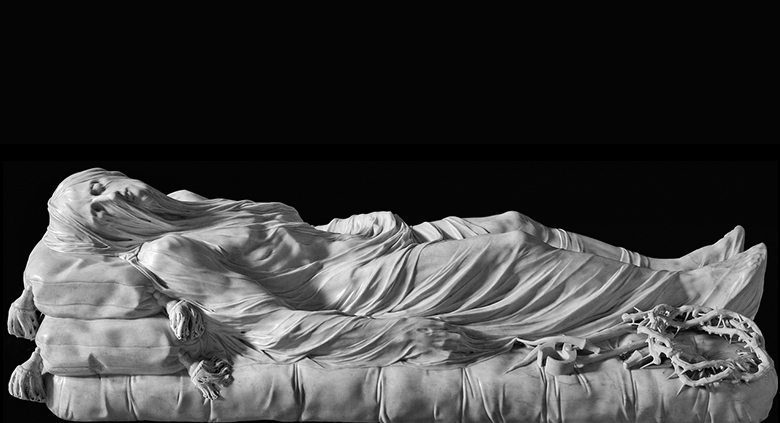Brief Overview
- The Veiled Christ, or Cristo Velato, is a marble sculpture completed in 1753 by Giuseppe Sammartino, located in the Cappella Sansevero in Naples, Italy.
- Originally commissioned to Antonio Corradini, the work was finished by Sammartino after Corradini’s death, showcasing a dead Christ covered by a seemingly transparent shroud.
- The sculpture’s remarkable detail has made it one of the most celebrated works of art in the world, admired by figures like Antonio Canova.
- Legends suggest the veil’s transparency resulted from alchemical processes, possibly linked to the sculpture’s commissioner, Raimondo di Sangro.
- From a Catholic perspective, the Veiled Christ invites reflection on Christ’s death and the mystery of the Incarnation, though no miraculous claims are officially endorsed by the Church.
- This article explores the sculpture’s artistic significance, the legends surrounding it, and its meaning within Catholic theology.
Detailed Response
The Historical Context of the Veiled Christ
The Veiled Christ was created in 1753, during a period when Baroque art dominated Europe. This style emphasized dramatic expressions of faith, often through intricate details and emotional intensity. Giuseppe Sammartino, a Neapolitan sculptor, took on the project after Antonio Corradini’s death. Corradini had prepared a clay model, but it was Sammartino who brought the vision to life in marble. The sculpture resides in the Cappella Sansevero, a small chapel commissioned by Raimondo di Sangro, a nobleman and intellectual. The work reflects the era’s focus on religious themes, particularly the suffering and death of Jesus Christ. Sammartino’s skill lies in his ability to carve a single block of marble into a figure that appears both solid and ethereal. The shroud over Christ’s body seems to cling to His form, revealing details beneath it. This artistic choice aligns with Baroque goals of evoking awe and contemplation. Historically, the sculpture stands as a testament to human creativity in service of faith.
The Artistic Mastery of Giuseppe Sammartino
Sammartino’s Veiled Christ is a marvel of sculptural technique. He carved the entire piece—Christ’s body and the veil—from one block of marble. The shroud appears almost transparent, allowing viewers to see the contours of Christ’s face, hands, and feet beneath it. This effect is achieved through precise thinning of the marble in certain areas. Unlike cloth, which can be layered, marble is unyielding, making Sammartino’s work extraordinary. The texture of the veil contrasts with the smoothness of Christ’s skin, enhancing the illusion of depth. Art historians praise this as a pinnacle of 18th-century sculpture. Antonio Canova, a leading neoclassical artist, reportedly admired it so much that he wished to own it. Sammartino’s skill invites viewers to marvel at human ingenuity. For Catholics, this artistry also points to the beauty of creation, reflecting God’s own creative power.
Legends of Alchemy and the Veil
Stories about the Veiled Christ often mention alchemy. Some claim Sammartino used a chemical process to turn a real linen veil into marble. Others link this idea to Raimondo di Sangro, the chapel’s patron, who was rumored to be an alchemist. These tales suggest di Sangro taught Sammartino a secret method to achieve the veil’s transparency. No evidence supports these claims. Marble cannot be created from cloth through any known process, chemical or otherwise. Scholars attribute the effect to Sammartino’s exceptional carving skills. The legends likely stem from di Sangro’s eccentric reputation and the sculpture’s striking appearance. In the 18th century, alchemy fascinated many, blending science and mysticism. While intriguing, these stories are folklore, not fact, and distract from the sculpture’s true merit.
Catholic Teaching on Miracles
In Catholic theology, a miracle is an extraordinary event attributable to divine intervention. The Church investigates claims of miracles carefully, requiring evidence beyond natural explanation (see CCC 156). The Veiled Christ’s transparency, while remarkable, does not meet this standard. It is a product of human skill, not a supernatural act. Catholics are free to admire the sculpture as art without attributing miraculous origins to it. The Church distinguishes between natural talents, like Sammartino’s, and divine acts, such as Christ’s Resurrection. Legends of alchemy might captivate the imagination, but they lack theological weight. The Catechism emphasizes faith in God’s power, not human speculation (see CCC 2116). Thus, the “miracle” of the Veiled Christ lies in its beauty, not in any mystical process. Catholics can appreciate it as a reflection of God’s gift of creativity.
The Theological Significance of the Veiled Christ
The Veiled Christ depicts Jesus after His crucifixion, lying in death. This image aligns with Catholic focus on Christ’s Passion and sacrifice. The veil over His body recalls the burial shroud, a symbol of His humanity and mortality. In John 19:40, the Gospel describes Jesus wrapped in linen cloths. Sammartino’s sculpture invites meditation on this moment of stillness before the Resurrection. The transparency of the veil suggests both death and the promise of life beyond it. For Catholics, Christ’s death is not an end but a passage to victory over sin (see CCC 654). The artwork captures this duality—visible suffering and hidden glory. It serves as a visual prayer, drawing viewers into the mystery of redemption. Theologically, it reflects the Incarnation: God made man, subject to death yet divine.
The Role of Art in Catholic Tradition
Art has long been central to Catholic worship and teaching. The Church values it as a means to express truth and inspire faith (see CCC 2501). Sculptures like the Veiled Christ help believers visualize sacred events. Sammartino’s work fits this tradition by portraying Christ’s sacrifice with reverence. The Catechism notes that art should elevate the mind to God (see CCC 2502). The sculpture’s beauty fulfills this purpose, offering a glimpse of divine mystery through human hands. Historically, Baroque art aimed to counter Protestant critiques by affirming the senses in worship. The Veiled Christ succeeds in this, engaging both sight and soul. It stands alongside works like Michelangelo’s Pietà in its devotional power. For Catholics, such art is not mere decoration but a bridge to contemplation.
Debunking the Alchemical Myth
The idea of a linen veil turned to marble lacks scientific basis. Marble is a metamorphic rock, formed over millennia under heat and pressure. No 18th-century process could replicate this naturally. Sammartino’s achievement rests on his ability to carve thin, translucent layers. Art experts confirm this through studies of the sculpture’s surface. Raimondo di Sangro’s interest in science may have fueled the alchemical rumors. He was a polymath, not a wizard, and his patronage reflects Enlightenment curiosity. The legend persists because the veil’s effect is so convincing. Yet, attributing it to alchemy undermines Sammartino’s talent. Catholics can reject this myth without diminishing the sculpture’s spiritual impact.
The Veiled Christ in the Cappella Sansevero
The sculpture resides in the Cappella Sansevero, a private chapel in Naples. Raimondo di Sangro designed it as a family mausoleum and a showcase for art. The Veiled Christ is its centerpiece, surrounded by other intricate works. The chapel’s intimate setting enhances the sculpture’s emotional resonance. Visitors often describe a sense of awe upon seeing it. The space reflects di Sangro’s vision of blending faith, art, and intellect. For Catholics, the chapel is not a consecrated church but a site of reflection. The sculpture’s placement invites quiet meditation on Christ’s death. Its preservation there ensures its legacy as a cultural and spiritual treasure. Today, it draws thousands annually, testifying to its enduring power.
Christ’s Shroud and Catholic Devotion
The veil in the sculpture evokes the burial cloths of Jesus. In Catholic tradition, these cloths hold deep significance, linked to relics like the Shroud of Turin. While the Veiled Christ is not a relic, it echoes this devotion. The Catechism speaks of Christ’s burial as preparation for His rising (see CCC 624). Sammartino’s shroud emphasizes this transition, blending realism with symbolism. The transparency hints at the glory beneath the veil of death. Devout Catholics may see parallels to the Eucharist, where Christ’s presence is veiled yet real (see CCC 1374). The sculpture thus resonates with liturgical themes. It invites believers to ponder the mystery of Christ’s body, dead yet destined for life. This connection enriches its place in Catholic spirituality.
Why the Veiled Christ Captivates
The sculpture’s appeal lies in its fusion of skill and meaning. The lifelike quality of Christ’s form draws viewers in. The veil’s transparency creates an illusion that defies marble’s nature. This combination leaves a lasting impression. For Catholics, it also carries spiritual weight, reflecting Christ’s sacrifice. Artistically, it showcases the heights of human ability. Emotionally, it stirs compassion for the suffering Christ. Intellectually, it prompts questions about its creation. Its fame grew through praise from figures like Canova. Ultimately, its power lies in its ability to speak across time and belief.
The Catholic View on Artistic Legends
Legends like the alchemical veil are common in art history. They often arise from marvel at human achievement. The Church does not condemn such stories but urges discernment (see CCC 2120). Faith rests on revelation, not speculation. The Veiled Christ’s value lies in its truth as art, not in fanciful origins. Catholics can enjoy the tales while grounding their appreciation in reason. The Catechism warns against superstition, which these legends border on (see CCC 2111). Sammartino’s work needs no myth to stand out. Its real miracle is the inspiration it offers. This balance reflects Catholic emphasis on both faith and intellect.
Comparing the Veiled Christ to Other Works
The Veiled Christ shares traits with other Catholic art. Michelangelo’s Pietà, for instance, also depicts Christ’s death with tenderness. Both use marble to convey profound emotion. Yet, Sammartino’s veil sets his work apart, adding a layer of mystery. Bernini’s Ecstasy of Saint Teresa, another Baroque piece, uses light and motion similarly. Each artist reflects their time’s style while honoring faith. The Veiled Christ’s focus on the shroud links it to burial themes in Christian art. Its realism rivals Renaissance works, though its drama is distinctly Baroque. This comparison highlights its unique place in tradition. For Catholics, it joins a lineage of art that glorifies God.
The Sculpture’s Impact on Faith
For many Catholics, the Veiled Christ deepens devotion. Its portrayal of Christ’s body invites reflection on the cross. The veil suggests both loss and hope, aligning with Easter’s message. Pilgrims to Naples often visit it for this reason. The Catechism ties Christ’s death to salvation (see CCC 601). Sammartino’s work makes this tangible. It bridges the historical event and personal faith. Some report feeling closer to Jesus through it. Others find it a reminder of mortality and grace. Its impact lies in its ability to stir the heart.
Preservation and Modern Appreciation
The Veiled Christ remains in excellent condition today. The Cappella Sansevero protects it from damage. Modern visitors marvel at its detail, aided by careful lighting. Art historians study it to understand Baroque techniques. Catholics see it as a living part of their heritage. Its fame has grown with global interest in religious art. Preservation efforts ensure its message endures. The sculpture’s accessibility makes it a point of connection across cultures. It continues to inspire awe, as it did in 1753. This longevity speaks to its universal resonance.
The Veil as a Symbol in Catholicism
Veils hold rich meaning in Catholic theology. They signify mystery, separation, and revelation. In Exodus 34:33-35, Moses veiled his face after meeting God. In the Mass, the Eucharist is veiled in the tabernacle. The Veiled Christ’s shroud fits this pattern, hiding yet revealing Christ’s glory. It points to the paradox of the Incarnation—God veiled in flesh. For believers, it symbolizes the thin divide between earth and heaven. Sammartino’s artistic veil amplifies this idea. It invites contemplation of what lies beyond sight. This symbolism deepens the sculpture’s spiritual layer.
Addressing Misconceptions
Some view the Veiled Christ as proof of supernatural forces. This stems from the alchemy legend. Others see it as mere decoration, missing its depth. Both views miss the mark. The Church clarifies that its value is artistic and devotional, not miraculous (see CCC 1162). Sammartino’s skill explains its effect, not magic. Nor is it trivial—it reflects core Catholic beliefs. Education about its context dispels these errors. Catholics can correct misconceptions by focusing on its true purpose. Clarity enhances appreciation of its place in faith.
The Veiled Christ and Human Creativity
Catholic teaching celebrates human creativity as a divine gift (see CCC 2500). The Veiled Christ exemplifies this. Sammartino’s talent mirrors God’s own act of creation. The sculpture’s beauty lifts the spirit toward the Creator. It shows what humans can achieve when inspired by faith. This aligns with the Church’s view of art as a noble calling. The veil’s craftsmanship reflects order and purpose. For Catholics, it affirms the dignity of work. It also reminds us of our capacity to reflect God’s image. This perspective frames the sculpture as a triumph of the human soul.
A Call to Reflection
The Veiled Christ invites all to pause and think. For Catholics, it recalls Christ’s love and sacrifice. Its artistry points to the goodness of creation. The veil suggests mysteries beyond this world. It bridges the physical and spiritual, a hallmark of Catholic thought. Visitors leave with a sense of wonder. The sculpture asks us to consider life, death, and what follows. Its silence speaks louder than words. For believers, it’s a call to prayer and gratitude. This reflective power is its lasting gift.
Conclusion: Art, Faith, and Truth
The Veiled Christ is no miracle of transparent marble in a supernatural sense. It is, however, a masterpiece of human skill and devotion. Sammartino’s work captures Christ’s death with striking realism. Legends of alchemy add intrigue but lack substance. Catholic teaching sees it as a reflection of faith, not a marvel of chemistry. Its true power lies in its ability to inspire awe and prayer. The sculpture unites art and theology in a profound way. It stands as a testament to the Church’s embrace of beauty. For Catholics, it offers a window into the Paschal Mystery. Ultimately, it glorifies God through the hands of man.
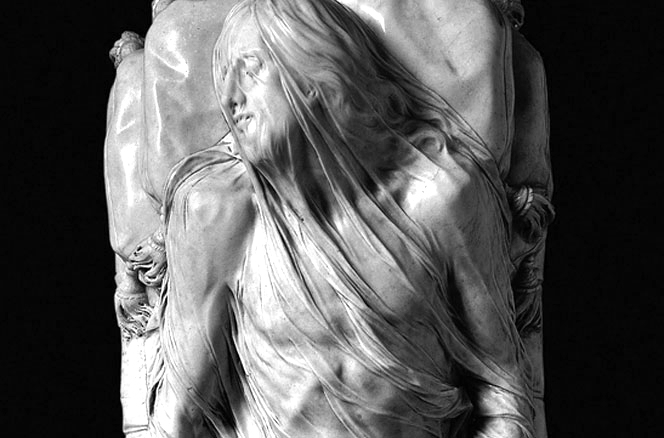
The Cristo Velato (that is, the Veiled Christ) is a sculpture completed in 1753, originally (mis)attributed to Antonio Corradini and considered one of the world’s most remarkable pieces of art.
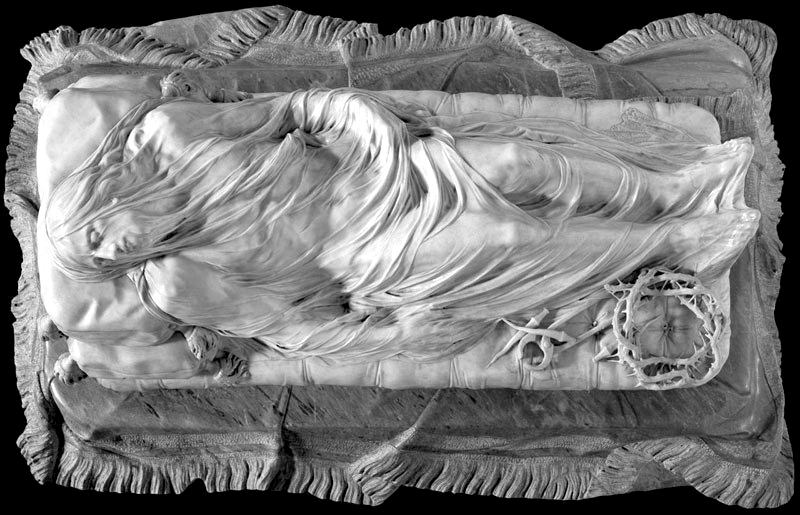
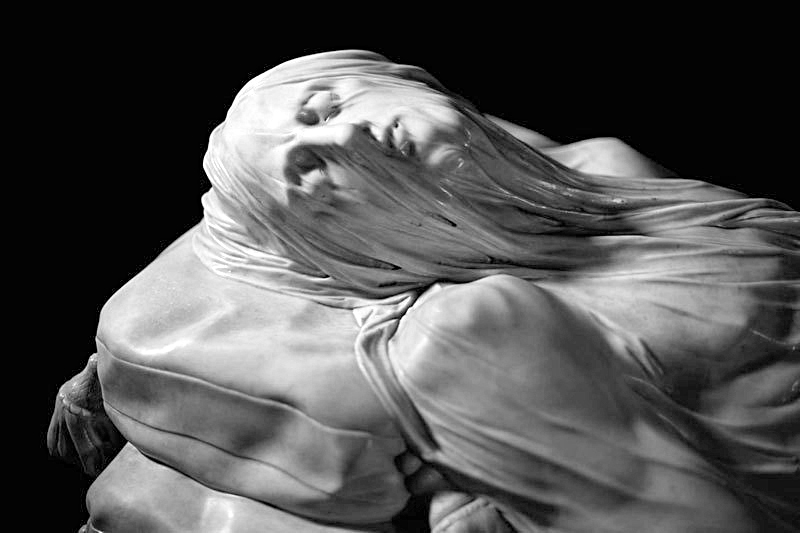
It was Giuseppe Sammartino, then, who ended up producing the astonishing sculpture of a dead Jesus, covered by a transparent shroud carved out of the very same marble block shared with the rest of the statue.
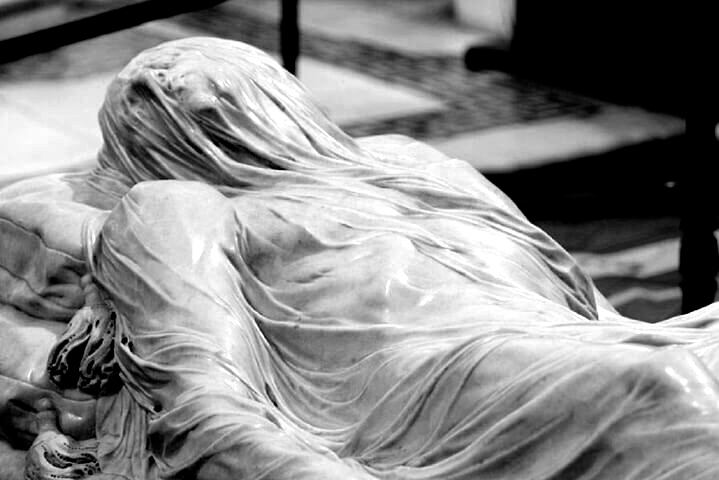
Signup for our Exclusive Newsletter
- Add CatholicShare as a Preferred Source on Google
- Join us on Patreon for premium content
- Checkout these Catholic audiobooks
- Get FREE Rosary Book
- Follow us on Flipboard
-

Discover hidden wisdom in Catholic books; invaluable guides enriching faith and satisfying curiosity. Explore now! #CommissionsEarned
- The Early Church Was the Catholic Church
- The Case for Catholicism - Answers to Classic and Contemporary Protestant Objections
- Meeting the Protestant Challenge: How to Answer 50 Biblical Objections to Catholic Beliefs
As an Amazon Associate, I earn from qualifying purchases. Thank you.

